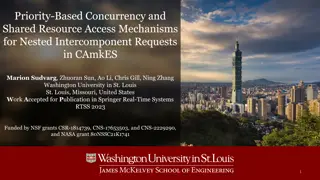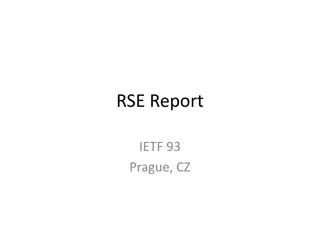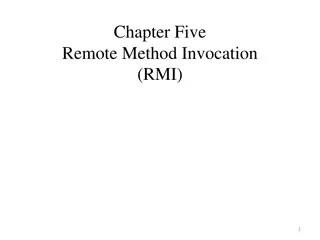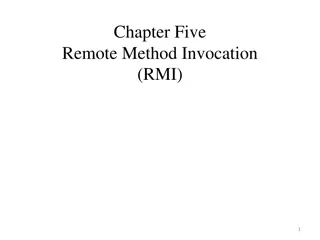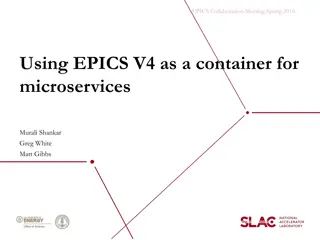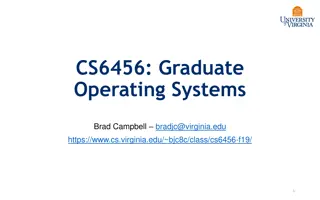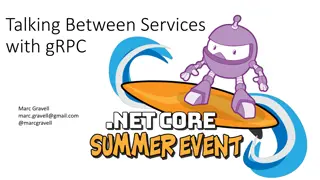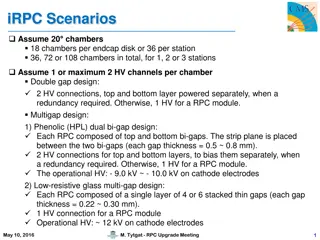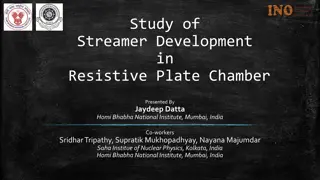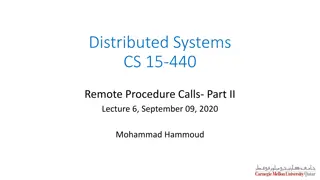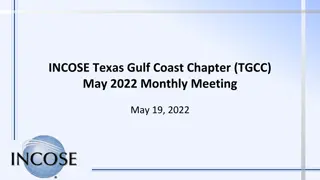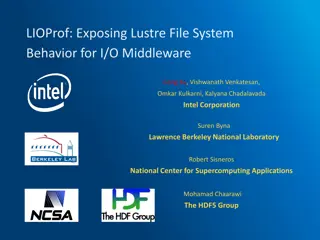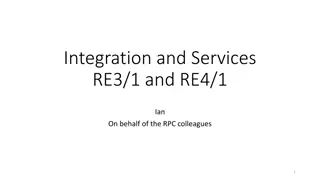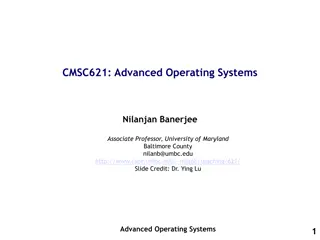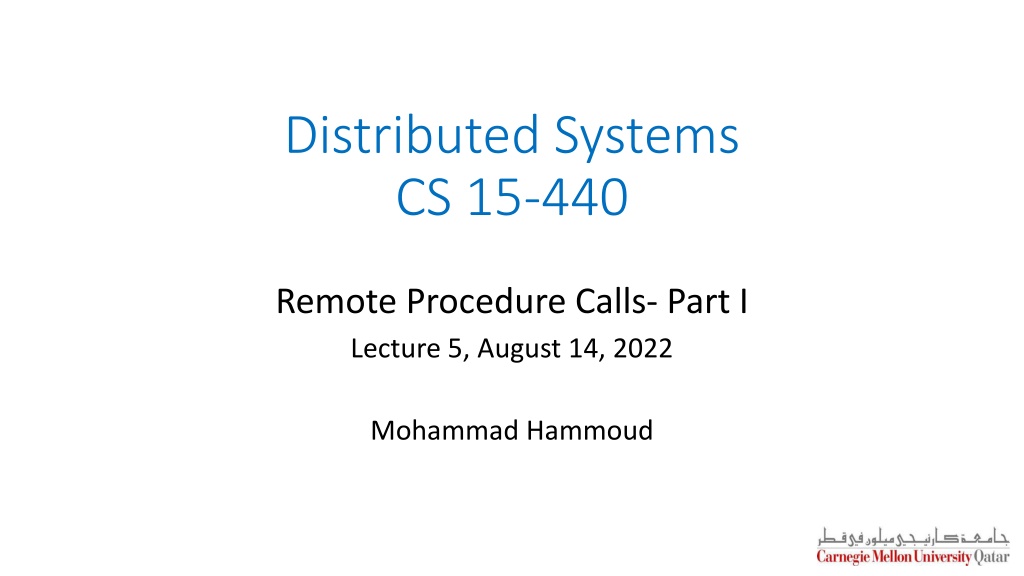
Understanding Distributed Systems Communication Paradigms
Explore how entities in distributed systems communicate through different paradigms, including remote procedure calls, sockets, and remote invocation. Learn about middleware layers, UDP sockets, and the classification of communication paradigms based on entity residency. Dive into the world of networking principles and discover the methods by which entities interact and exchange data in distributed systems.
Download Presentation

Please find below an Image/Link to download the presentation.
The content on the website is provided AS IS for your information and personal use only. It may not be sold, licensed, or shared on other websites without obtaining consent from the author. Download presentation by click this link. If you encounter any issues during the download, it is possible that the publisher has removed the file from their server.
E N D
Presentation Transcript
Distributed Systems CS 15-440 Remote Procedure Calls- Part I Lecture 5, August 14, 2022 Mohammad Hammoud
Today Last Session: Networking- Part II Networking Principles: Encapsulation, Routing, and Congestion Control Today s Session: Remote Procedure Calls- Part I Sockets Remote Invocations Announcements: PS1 is due today by midnight Project I will be out on August 16; it is due on Sep 11 (design report is due on August 28)
Communicating Entities in Distributed Systems Communicating entities in distributed systems can be classified into two types: System-oriented entities Processes Threads Nodes Problem-oriented entities Objects (in object-oriented programming based approaches) How can entities in distributed systems communicate?
Communication Paradigms Communication paradigms describe and classify a set of methods by which entities can interact and exchange data
Classification of Communication Paradigms Communication paradigms can be categorized into three types based on where the entities reside. If entities are running on: 1. Same Address-Space Global variables, Procedure calls, Today, we will study how entities that reside on networked computers communicate in distributed systems using socket communication and remote invocation 2. Same Computer but Different Address-Spaces Files, Signals, Shared Memory 3. Networked Computers Socket Communication Remote Invocation
Middleware Layers Applications, Services Remote Invocation Middleware Layers IPC Primitives (e.g., Sockets) Transport Layer (TCP/UDP) Network Layer (IP) Data-Link Layer Physical Layer 6
UDP Sockets UDP provides connectionless communication, with no acknowledgements or message retransmissions Communication mechanism: Server opens a UDP socket SS at a known port sp, Socket SS waits to receive a request Client opens a UDP socket CS at a random port cx Client socket CS sends a message to ServerIP and port sp Server socket SS may send back data to CS Server SS.receive(recvPacket) Client No ACK will be sent by the receiver CS.Send(msg, ServerIP, sp) CS cx SS sp SS.Send(msg, recvPacket.IP, recvPacket.port) H = Host computer H S = Socket S = Port n n
UDP Design Considerations Sender must explicitly fragment a long message into smaller chunks before transmission A maximum size of 548 bytes is suggested for transmission Messages may be delivered out-of-order If necessary, programmer must re-order packets Communication is not reliable Messages might be dropped due to check-sum errors or buffer overflows at routers Receiver should allocate a buffer that is big enough to fit the sender s message Otherwise the message will be truncated
TCP Sockets TCP provides in-order delivery, reliability, and congestion control Communication mechanism: Server opens a TCP server socket SS at a known port sp Server waits to receive a request (using accept call) Client opens a TCP socket CS at a random port cx CS initiatesa connection initiation message to ServerIP and port sp Server socket SS allocates a new socket NSS on random port nsp for the client CS can send data to NSS nSS = SS.accept() Client Server SS sp CS cx nSS nsp
Main Advantages of TCP TCP ensures in-order delivery of messages Applications can send messages of any size TCP ensures reliable communication via using acknowledgements and retransmissions Congestion control of TCP regulates sender rate, and thus prevents network overload
Middleware Layers Applications, Services Remote Invocation Middleware Layers IPC Primitives (e.g., Sockets) Transport Layer (TCP/UDP) Network Layer (IP) Data-Link Layer Physical Layer 11
Remote Invocation Remote invocation enables an entity to call a procedure that typically executes on an another computer without the programmer explicitly coding the details of communication The underlying middleware will take care of raw-communication Programmer can transparently communicate with remote entity We will study two types of remote invocations: a.Remote Procedure Calls (RPC) b.Remote Method Invocation (RMI)
Remote Procedure Calls (RPC) RPC enables a sender to communicate with a receiver using a simple procedure call No communication or message-passing is visible to the programmer Basic RPC Approach: Machine A Client Machine B Server Client Program Communication Module Communication Module Server Procedure Request int add(int x, int y) { return x+y; } add(a,b) ; Response Client process Server process Client Stub Server Stub (Skeleton)
Client Stub The client stub: Gets invoked by user code as a local procedure Packs (or serializes or marshals) parameters into a request packet (say, request-pkt) Invokes a client side transport routine (e.g., makerpc(request-pkt, &reply-pkt)) Unpacks (or de-serializes or unmarshals) reply-pkt into output parameters Returns to user code
Server Stub The server stub: Gets invoked after a server side transport routine (e.g., getrequest()) is returned Unmarshals arguments, de-multiplexes opcode, and invokes local server code Marshals arguments, invokes a server-side transport routine (e.g., sendresponse()), and returns to server loop E.g., Typical server main loop: while (1) { } get-request (&p); /* blocking call */ execute-request (p); /* demux based on opcode */
Challenges in RPC Parameter passing via marshaling Procedure parameters and results have to be transferred over the network as bits Data representation Data representation has to be uniform Architecture of the sender and receiver machines may differ Failure Independence Client and server might fail independently
Challenges in RPC Parameter passing via marshaling Procedure parameters and results have to be transferred over the network as bits Data representation Data representation has to be uniform Architecture of the sender and receiver machines may differ Failure Independence Client and server might fail independently
Parameter Passing via Marshaling Packing parameters into a message that will be transmitted over the network is called parameter marshalling The parameters to the procedure and the result have to be marshaled before transmitting them over the network Two types of parameters can be passed: 1. Value parameters 2. Reference parameters
1. Passing Value Parameters Value parameters have complete information about the variable, and can be directly encoded into the message E.g., integer, float, character Values are passed through call-by-value The changes made by the callee procedure are not reflected in the caller procedure
2. Passing Reference Parameters Passing reference parameters like value parameters in RPC leads to incorrect results due to two reasons: a. Invalidity of reference parameters at the server Reference parameters are valid only within client s address space Solution: Pass the reference parameter by copying the data that is referenced b. Changes to reference parameters are not reflected back at the client Solution: Copy/Restore the data Copy the data that is referenced by the parameter Copy-back the value at server to the client
Challenges in RPC Parameter passing via marshaling Procedure parameters and results have to be transferred over the network as bits Data representation Data representation has to be uniform Architecture of the sender and receiver machines may differ Failure Independence Client and server might fail independently
Data Representation Computers in DSs often have different architectures and operating systems The size of the data-type differ E.g., A long data-type is 4-bytes in 32-bit Unix, while it is 8-bytes in 64-bit Unix systems The format in which the data is stored differs E.g., Intel stores data in little-endian format, while SPARC stores in big-endian format The client and server have to agree on how simple data is represented in the message E.g., Format and size of data-types such as integer, char and float
Challenges in RPC Parameter passing via marshaling Procedure parameters and results have to be transferred over the network as bits Data representation Data representation has to be uniform Architecture of the sender and receiver machines may differ Failure Independence Client and server might fail independently
Failure Independence In the local case, the client and server live or die together In the remote case, the client sees new failure types (more on this next lecture) Network failure Server machine crash Server process crash Thus, failure handling code has to be more thorough (and essentially more complex)
Remote Procedure Call Types Remote procedure calls can be: Synchronous Asynchronous (or Deferred Synchronous)
Synchronous vs. Asynchronous RPCs An RPC with strict request-reply blocks the client until the server returns Blocking wastes resources at the client Asynchronous RPCs are used if the client does not need the result from server The server immediately sends an ACK back to the client The client continues the execution after an ACK from the server wait for acceptance client wait for result Client call remote procedure return from call return from call call remote procedure request reply request accept request Server server call local procedure call local procedure and return results time time Synchronous RPCs Asynchronous RPCs
Deferred Synchronous RPCs Asynchronous RPC is also useful when a client wants the results, but does not want to be blocked until the call finishes Client uses deferred synchronous RPCs Single request-response RPC is split into two RPCs First, client triggers an asynchronous RPC on server Second, on completion, server calls-back client to deliver the results interrupt client wait for acceptance client return from call call remote procedure return results acknowledge accept request request server call local procedure time call client with asynchronous RPC
Remote Method Invocation (RMI) RMI is similar to RPC, but in a world of distributed objects The programmer can use the full expressive power of object-oriented programming RMI not only allows to pass value parameters, but also pass object references In RMI, a calling object can invoke a method on a potentially remote object
Remote Objects and Supporting Modules In RMI, objects whose methods can be invoked remotely are known as remote objects Remote objects implement remote interfaces During any method call, the system has to resolve whether the method is being called on a local or a remote object Local calls should be called on a local object Remote calls should be called via remote method invocation Remote Reference Module is responsible for translating between local and remote object references
RMI Control Flow Machine A Client Machine B Server Communication Module Communication Module Skeleton and Dispatcher for B s class Request Proxy for B Obj A Remote Obj B Remote Reference Module Response Remote Reference Module
Next class Remote Procedure Calls- Part II

